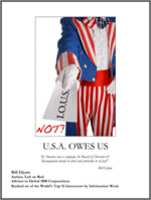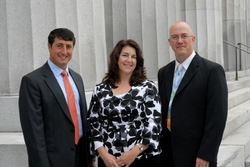
Nashville, TN (PRWEB) October 7, 2008
Bill Glynn, controversial author of “Left on Red,” ranked one of the top 15 innovators in the world, takes on economic and social issues looming over America and the world economy and offers simple to understand explanations and solutions for our woes. He has appeared with Fox Business network anchor Neil Cavuto, is a regular guest on over 80 radio stations and broadcast networks nationwide and has joined leaders including Hugh Hewitt, Rita Cosby, Ross Perot and many others in presenting his solutions on the failing economy.
A movie and short book – I.O.U.S.A.- recently examined the spiraling national debt and economic decay presenting the facts and interviews from America’s most successful and brightest executives including Alan Greenspan. The U.S., burdened now with $ 10 trillion in debt, is on the verge of bankruptcy and I.O.U.S.A. painted a grave picture of these facts. Bill Glynn believes we are owed answers and solutions to protect our way of life. In fact, he is often quoted saying:
“If America were a company, and we should be viewed as such as a Capitalist Nation, our Board of Directors and Management would be fired and in Jail.”
As a shareholder of this nation demanding solutions to America’s problems, Bill Glynn has written I.O.U.S.A. NOT! – USA Owes US. The document is 40 pages and free to download at http://www.billglynn.net . He addresses eleven sore subjects (only a few of many) that America must overcome in order to keep our society and way of life going. In the first chapter, The Silver Bullet, he outlines a variety of ways we can move forward to solve some the present economic woes and the many issues facing our country.
According to Bill Glynn, if we allow the government to do more of the same, we will lose international confidence and will be cut off from those nations buying our debt that are keeping the USA from bankruptcy right now. As bleak as all this sounds, Glynn says his solutions are simple and attack the very cancer that is crippling our nation economically and socially. According to Glynn, his pioneering 10% solution to eradicate the U.S. deficit is among the most noted across the country. Glynn continues by saying, if you plan to vote for McCain and Palin or Obama and Biden this hand guide will wake you up and provide education and insight on issues everyone should understand going into one of the most important elections in our lifetime.
About Bill Glynn
Bill Glynn is a successful entrepreneur, author of Left on Red (Wiley & Sons) and voted one of the world’s top 15 innovators by Information week. He advises leaders of over 20 global 1000 companies, is an influential insider in music and film entertainment and manages, advises various venture funds and businesses he has founded, incubated or facilitated. He is credited with helping Chat and Instant Messaging become pervasive across the Web, the creation of landscaping appraising and insurance underwriting for landscaping, foundation work in securitizing private equity through the collateralized private equity obligation among many more. He has raised over $ 1 billion for the funds and private ventures he has helped create and advised. He serves the leadership of London’s Royal Institution’s World Science Assembly and the East West Institute where he focuses on the weaponization of science and harmonizing humanity among the major faiths on earth.
Bill Glynn helped build Southeast Interactive Tech Funds and was an early investor in How Stuff Works; Arsenal Digital, Opensite, Instant Messaging (IM) and Chat; Tom Clancy Red Storm Entertainment, HAHT Commerce, Interactive Magic, he is the founder of Collective IQ, Money Grows on Trees, Horticultural Asset Management, Pearl Street Capital and works as a corporate venture and development advisor for Molson Coors, Xcel Energy, Fujitsu, Global Exchange, Wrigley, Teradata, Western Union, First Data, SAS, Alticor, Amway, Legendary Pictures, Provident Music, Landis Entertainment, CCLI, The Strategic Venture Association, The Gulf Venture Association, The Briner Institute, East West Institute, The Royal Institution in London among others.
Bill Glynn
http://www.billglynn.net
info@collectiveiq.com
Media Contact
Sandy Frazier
(516) 735-5468
sandy@mystic-art.com
http://www.SandyPR.com
###



